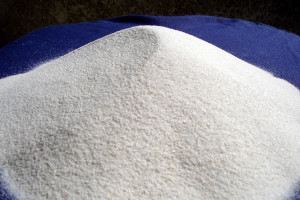| Abadgaran Arvand Shimi |

| Registration Date | 14 Apr 2018 |
| Revision Date | 14 Apr 2018 |
| Share |
Environment Air Remediation
Environmental CatalystZeolite
Na2Al2Si3O10·2H2O Nanoporous CAS Number : 1318-02-1This product is a synthetic zeolite 4A with an XRD pattern consistent with its standard one. Considering L.O.I, the purity of this product is 99.4%. It should be noted that the high L.O.I in this product arises from the high moisture absorption of zeolite. Zeolite due to its nano-scale porosities has some advantages such as reduced or inexistent mass transfer limitations, large external surface area and high surface charge.
Zeolites are highly crystalline hydrated aluminosilicates from the alkali metals and alkali earth metals groups. Their structural arrangement presents sockets and interconnected channels in which compensation ions, such as Na+, Ca2+, Mg2+, K+ and H2O, are present. This microporous structure enables zeolites to have a large surface area in relation to the external one. The zeolite structure allows the transference of substances between the intercrystalline spaces. Zeolites can be classified according to pore size into the following categories: extra-large pore zeolites (Θ≥ 9A˚), large pore zeolites (6˚A < Θ < 9A˚), medium pore zeolites (5˚A < Θ≤ 6A˚) and small pore zeolites (3˚A < Θ≤ 5A˚), depending on the access to the inner part using 8, 10 or 12 atoms oxygen rings, respectively. Due to the position of the cations in the zeolite structure, the effective pore diameter may vary according to the type of compensation cation. If the cation is sodium (Na+), the opening is 4A˚, and the material is referred to as 4A zeolite. Zeolites occur naturally but are also produced industrially on a large scale. 229 unique zeolite frameworks have been identified, and over 40 naturally occurring zeolite frameworks are known. Naturally occurring zeolites are rarely pure and are contaminated to varying degrees by other minerals, metals, quartz, or other zeolites. Synthetic zeolites are made from various materials, including industrial residues and clays. They are manufactured under carefully controlled physical and chemical conditions. By varying the synthesis conditions, one may obtain zeolites with different structural characteristics and chemical composition.